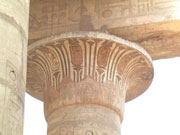TOUR NEWS - TURKEY MARCH-APRIL 2013
In March-April 2013 Ian Casey and I had 5 weeks in Turkey making the final preparations for the upcoming tour of Eastern Turkey which will run in September this year. I had travelled through Eastern Turkey many years ago and was interested to see the sites again and make decisions about the hotels, and refine the itinerary.
We arrived into Istanbul on the 24th March and we had a few days to revisit some of the most important sites. We walked around the historic quarter of the city and met up with our local guide Sevil Yalcin who would be coming with us to the east. We headed by tram along the edge of the Bosphorus to the Rulemi Hissari, a wonderful 15th Century castle built by Ottoman Sultan Mehmet the Conqueror in the run up to his conquest of Constantinople. The castle dominated the strategic waterway and made victory certain. The following day we visited the Haghia Sophia, the stunning 6th Century basilica of Justinian and also explored the nearby tombs of the Ottoman Sultans which contain magnificent tile work. We then walked to the Suleymania Mosque, built by master architect Sinan for Suleymen the Magnificent in the mid 16th Century. The gardens around the mosque were abloom with spectacular tulips. We then explored some of the Grand Bazaar � a warren of 3000 shops under cover and many more in the surrounding streets.
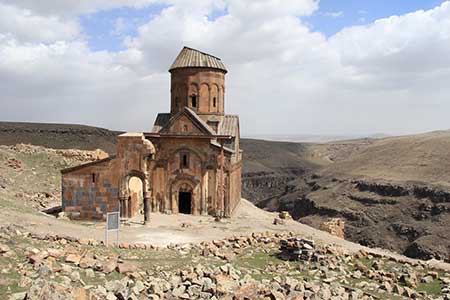 |
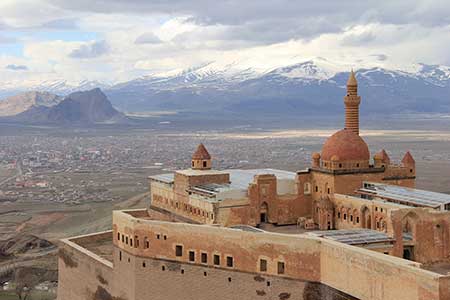 |
The ruins of Ani |
The Ishak Pasha Saray at Dogubayazit |
The following day we hired a car and drove north of Istanbul to visit the beautiful early Ottoman city of Edirne. This was the capital of the growing empire before the conquest of Constantinople in 1453 and contains many stunning monuments from the period. We saw the Ulu Camii (Great Mosque), the markets and the incomparable Selimya Mosque with a stunning painted dome. We also saw the magnificent complex of Beyazit which contains a Museum of Islamic Medicine.
The following day we flew across almost the entire country to the remote city of Kars near the Armenian border. Much of the Anatolian plateau was covered with snow and the city felt remote and exotic. We were met by our driver who would stay with us for the rest of the trip and make our life so much easier. We went for a walk around the old quarter of Kars. We saw the dark stone Armenian Church of the Twelve Apostles which dates to the 10th Century, and also a 15th Century stone bridge across the river. A short walk up the hill took us to the ancient Selcuk era fortress above the town with wonderful views across the city.
The following day we went to Ani, the ancient capital of Armenia, located on the eastern frontier of Turkey. It is a huge site built in a dramatic location overlooking the Akhurian River. The land walls are impressive and once inside you can see the ruins of numerous churches and far off the citadel. We enjoyed seeing the early 11th Century frescoes and especially the enormous cathedral. All around were the snow covered hills, many of them ancient extinct volcanos. We returned to Kars to see the local museum and also tried the local hammam under our hotel.
Our journey then took us south. We left Kars and passed through a spectacular volcanic landscape � all around us were old cinder cones and lava flows. We passed close by the border between Turkey and Armenia and stopped at a caf� with views of Mt Ararat. We then headed to Dogubeyazit, a late 18th Century castle built to guard the Silk Road pass into Iran. The castle is located in a dramatic landscape and has been extensively restored since I saw it last. The stone carving is wonderful. We also saw a Urartian inscription carved in the cliffs nearby. We then continued our journey south over a mountain pass between two volcanoes covered with snow. We got out of the car to get some photos and felt some light snowfall � we also stopped to see an impressive waterfall of melting snow. We then continued on to the city of Van.
 |
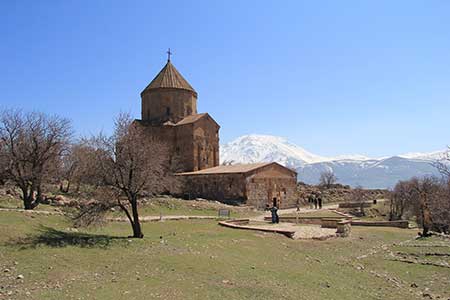 |
Hosap Castle |
Armenian church on Ahdamar Island |
On the 30th March we drove east of Van through mountainous country to see the mid 17th Century castle at Hosap. Perched on a dramatic rock and guarding a pass into Iran it is like something out of fantasy. We then stopped to see the ancient Urartian fortress of Cavustepe (8th Century BC). Located on a hill surrounded by a fertile plain and the snow-capped mountains, it consists of well-built stone walls, a palace and two temples � it reminded me of Tiryns in Greece. We then returned to Van and saw the spectacular castle which hovers over the town. It looks out over Lake Van, the most recent sections made of mudbrick over an ancient Urartian base. We climbed down into the tomb of ancient Urartian King Argishti and saw his biographical inscription in cuneiform.
The following day we drove down to the ancient city of Diyarbakir, dramatically located above the Tigris River. We left Van skirting the shore of the Lake, stopping to take a ferry over to Ahdamar Island. All around were the snow-capped mountains including a number of volcanoes. In a beautiful woodland setting on the island there is the very well preserved Armenian Church of the Holy Cross dating from the 10th century. The external surface is decorated with wonderful relief showing scenes from the Old Testament. Inside, there are some beautiful painted frescoes. We then continued on our journey by bus, stopping in Tatvan for lunch and seeing an Ottoman han (traveller�s inn) with the enormous snow covered Nemrut Dagi volcano rising up behind it. Our journey led us down off the Anatolian Plateau onto broad plains of wheat fields which spread as far as the eye could see. As the sun was setting we passed over the Tigris River and could see the black walls of Diyarabakir rising up in front of us. We stayed in a hotel which was a converted 500 year old Ottoman han � the rooms were basic but we wondered about the other travellers who had previously stayed there.
The 1st April was devoted to our exploration of Diyarbakir. We walked down to the Mardin Gate and explored some of the ancient walls of the city. Originally built in the 4th Century by Constantine II, they were reconstructed by the Selcuks in the 11th Century. It was fascinating to explore inside one of the bastions and see the Tigris Valley. We walked up through the main street exploring some of the old mosques and churches (including a rebuilt Armenian church) and visited the food markets; cheese is a speciality of the region. We particularly enjoyed the Hassan Pasha Han (a medieaval caravanserai) which apart from having nice shops is used for outdoor cafes. We explored the Great Mosque which incorporates ancient Roman structures and also saw the Syrian Orthodox church of Mary. We had a walk along the black walls of the city and climbed up for a superb view. In the afternoon we headed south, following the Tigris River for a while until we came to the hill town of Mardin � the view across the Syrian Plain to the border with Syria was magical.
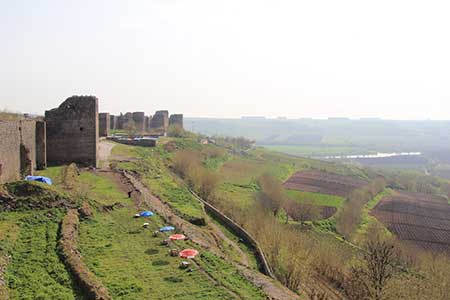 |
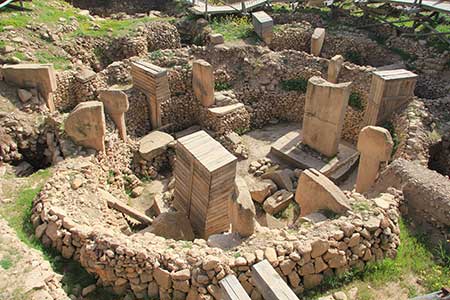 |
The basalt walls of Diyarbakir |
The pre-Neolithic Temples of Gobekli Tepe |
Mardin is a beautiful ancient city with an exotic otherworldly feel. We explored the ancient mosques and madrasas of the city, many of which date to the 12th -14th Centuries. We wandered through the markets of the city and found a very nice little caf� next to the Great Mosque which sold menenjich, a very pleasant coffee-like drink made form a local plant. We also drove to the ancient Saffron Monastery which lies very close to the Syrian frontier. An important base of the Syrian Orthodox Church, the monastery now houses many refugees from the Syrian conflict and may house the Syrian Orthodox patriarch in the future. We also explored the ruins of ancient Dara, an early Byzantine city founded by Anastasius in the late 5th Century to guard the frontier against Persian invasions � it preserves sections of the impressive walls and an enormous underground water cistern. We lastly visited the Mardin Museum of Archaeology.
In the morning we headed west, skirting along the Syrian border, where we saw many ancient 'tell' sites in the fields � these are manmade hills created by successive layers of ancient civilization. We stopped to have lunch in Viransehir and then our journey took us to the excavations of the remarkable pre-Neolithic temple at Gobekli Tepe. At least 16 stone circles have been discovered, the pillars carved with numerous animal motifs including jackals, spiders and vultures. Constructed around 10,000 BC it is the earliest known man-made place of worship. There was then just a short drive to the important mediaeval city of Sanliurfa.
On the 5th April we explored the historical centre of Sanliurfa. We visited the famous fish pools and the Prophet Abraham's cave. We also walked around the Abbasid/Crusader citadel on the summit of the hill and explored the wonderful covered bazaar with its ancient hans. The Sanliurfa Museum is very interesting as it contains sculpture from Gobekli Tepe and other nearby sites. The next day we drove south to the Syrian frontier to see the ancient site of Harran. Our route took us past a number of ancient tells on the north Syrian plain including Sultantepe, an important Assyrian site. We climbed to the summit of the mound and found many pieces of ancient pottery being weathered out of the hill. At Harran we explored the ancient walls of the city, saw the impressive ruins of the 8th Century Umayyad mosque, saw the citadel which is currently under restoration, and visited one of the few surviving traditional beehive dome houses.
In the morning we headed north to the Euphrates Dam (also called the Ataturk Dam). We then headed inland into the region known in antiquity as Commagene, a stunning part of the world. We drove to the summit of Mt Nemrut to see the magnificent stone figures which decorate the tomb of Antiochus I of Commagene, built around 80 BC. Each side of the burial mound contains an impressive series of stone sculptures of the gods on either side of the king � the western side of the mound was still deeply buried in snow and the statues were hidden from view. We also saw the almost intact Cendere Roman Bridge, built by the Emperor Septimius Severus, and the Karakus Tumulus, a royal burial mounds from the ancient Kingdom of Commagene. We then drove down to Gazantep.
In the morning we visited the Gaziantep Museum which is renowned for its superb collection of mosaics. These wonderful art works were rescued from the ancient Roman city of Zeugma which was partially flooded by the building of the Birecik Dam on the Euphrates River. The subject matters are diverse with famous themes from Greek myth predominating. The museum also contains some superb sculpture including an intact bronze sculpture of Mars. In the afternoon we went for a walk around the historic quarter of Gaziantep � this is nestled around the foot of the well preserved Selcuk citadel located on the ancient city mound. We walked through the covered bazaar (which has some nice fossils) and a numb er of historic hans (caravanserais).
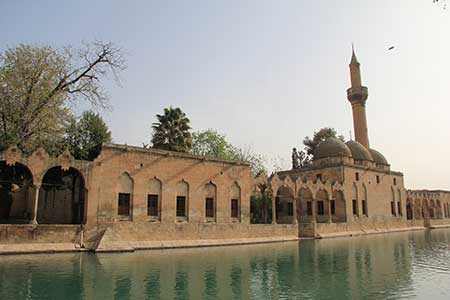 |
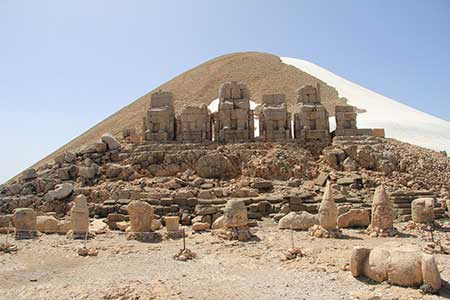 |
The shrines of Sanliurfa |
The colossal statues at Nemrut Dagi |
Our travels next took us west and south towards Antioch. En route around the edge of the Syrian frontier we stopped to see the ancient tell site of Zincirli. This was the site of an important Neo-Hittite town (10th-8th Century BC) with a well decorated citadel and we were able to trace parts of the ancient circuit and where recent excavation has been taking place. We also stopped to see the ancient quarry at Yesemak which was used to make carved stone statues to decorate Neo-Hittite cities. More than 300 statues are spread throughout the area, representing wild animals, sphinxes and mountain gods. We were very close to the Syrian frontier and could see numerous tell sites spread across the agricultural zone.
We stayed two nights in Antakya (ancient Antioch). We used it as a base to visit the wonderful site of Tell Atchana (the ancient site of Alalakh) which has been excavated by Leonard Woolley in the early 20th Century and is currently being further investigated. The remains of two impressive palaces have been exposed dating from the 18th Century and 15th Century BC � the city was sacked by Ramesses II in 1285 BC. We then drove to the south of Antakya to visit the national park around Daphne. This scenic spot was famous in antiquity as one of the most beautiful places known, but today its overdevelopment has left it rather sad. After that we drove down the Orontes River Valley to Seleuceia Pieria, the ancient port zone of Antioch. We explored the walls of the ancient city and also the ancient Roman water tunnel. We had a nice fish meal overlooking the Mediterranean. In Antakya we went for a walk through the historic quarter, including the ancient bazaar, and also visited the Archaeology Museum. This is currently being overhauled and a number of the rooms were closed, but we did see some splendid Roman mosaics from the local area.
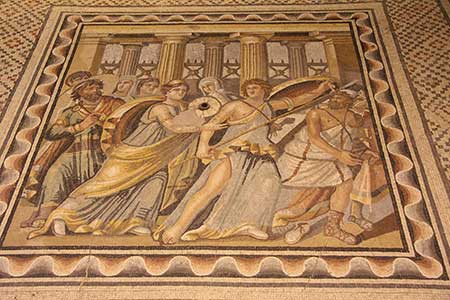 |
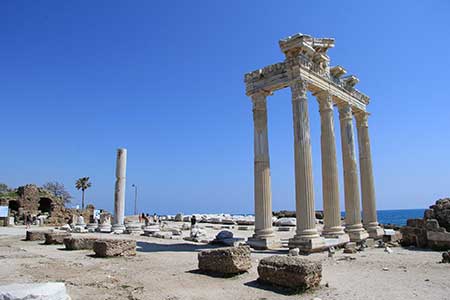 |
Mosaic from Zeugma in the Gaziantep Museum |
The Temple of Athena at Side |
On the 8th April we drove north of Antioch, crossing over the Amanus Mountains and came down onto the coastal plain, stopping to the see the River Issus where the famous Battle took place between Alexander the Great and Darius III in 333 BC. Nearby we explored the Sokollu Mehmet Caravanserai which was constructed by the famous Ottoman architect Sinan in 1574 � the complex is very beautiful and is currently being restored. Nearby we saw a 14th Century Venetian fortress. We were now passing into ancient Cilicia, renowned for its many castles from the Crusader era. We stopped to explore the impressive Toprakkale castle, built in the 12th Century to guard the passes into Syria. We had some lunch in the nearby village and then continued on our way to the Mediterranean port of Kizkalesi, stopping en route to explore the spectacular Armenian Castle called Yilankale. Perched on a sheer rock, the stunning complex gave an excellent view across the landscape.
Kizkalesi is famous for its sea castle which guarded the entrance to the harbour � another land castle on the shore lies close to the ruins of ancient Corycus. During our stay we enjoyed exploring the ruins of the ancient town and also walked over the ruins of the land castle. We decided to drive back along the coast to see the town of Tarsus, famous as the place where Cleopatra came to meet Antony. It is also famous as the birthplace of St Paul. Not much of the ancient city survives, but we saw the modern church of St Paul and the Great Mosque which dates from the 16th century. In the afternoon we headed we headed north of Kizkalesi to see the spectacular Temple of Zeus in the ancient city of Olba (ancient Diocaesarea). The ancient site is located under the small peaceful modern village - we explored the remains of a small Roman theatre, a Temple to Tyche, a Hellenistic tower and tomb, and an impressive gate constructed by the Emperor Arcadius in the early 5th Century.
We headed west along the Mediterranean Coast, stopping in Silifke to see the Armenian and Ottoman castle on the summit of the hill, and have a look at the 2nd Century AD Temple of Zeus. Our drive took us through winding roads along the coastal margin with occasional castles to see. We stopped at the remarkable Mamure Kalesi built by the Selcuks in the 13th Century. The castle occupies a peninsula and is surrounded on the land side by a moat which is full of tortoises. Enormous walls and an inner keep were thoroughly explored and photographed from every angle and we had a wonderful lunch opposite the castle. We then drove on to see the ancient site of Anemurion, an extensive Hellenistic and Roman site which includes a vast cemetery of family mausolea, Roman bath and gymnasium with mosaics, and the ruins of an ancient temple now visible in the ocean. We decided to stay overnight in Alanya, the ancient city of Coracesium. The city was very touristy in comparison with the parts of Turkey that we had previously seen. The most spectacular feature was the enormous Selcuk fortress dramatically located on the peninsula � the Red Tower near the harbour was a most impressive feature.
 |
 |
The theatre of Termessos |
Artemis in the Antalya Museum |
The following morning we continued our journey west along the coast, stopping to see the remains of an Selyck caravanserai called Sarapsa Hani, built in the mid-13th Century. This was an inn between Alanya and Konya and today is used as a wedding venue! We also diverted off the road to see the impressive Alarahan, another 13th Century caravanserai on the road to Konya. The inn stood lay near a bridge across the Alara River � on the opposite side was the impressive Alarakale, a dramatically located castle guarding the passage of the river. We had a cup of tea watched closely by the owner goat.
Further along the coast we came to the remarkable ancient site of Side, located on a promontory projecting into the Mediterranean. Archaeologists have uncovered the remains of the enormous ancient theatre, a state agora with round temple to Tyche, beautiful Temples of Apollo and Athena down near the harbour, and a grand colonnaded street with shops. We enjoyed the Side site Museum which has an impressive collection of sculpture from the area. In the afternoon there was a short drive to Antalya where we checked into our hotel in the old city.
The city of Antalya is very ancient, being refounded in the 2nd Century BC by the kings of Pergamon on an earlier foundation. We stayed in the historic and interesting old quarter with lots of narrow lanes and shopping areas. This would be our base for a few days to explore the surrounding sites. We headed into the rugged mountains behind Antalya to visit the Karain Cave where archaeologists have discovered some of the earliest evidence of humans in Turkey dating back at least 400,000 years. The view from the cave mouth was spectacular. We then drove south to visit the stunning Hellenistic and Roman city of Termessos. This mountain top city has remains of many temples, gymnasium, council chambers and a spectacularly located theatre with views over the valley. The numerous necropoli contain decorated and inscribed sarcophagi which emerge from a woodland setting.
The next day we drove SW from Antalya to visit the woodland site of Phaselis. We passed through dramatic mountain scenery to get there � this ancient Hellenistic and Roman site is located on a peninsula in a delightful sylvan setting which hides an impressive theatre, Roman bath complexes, an agora and houses. On our return to Antalya we explored the old part of the city including a number of mosques and the impressive Gate of Hadrian. Built to commemorate the arrival of the Roman Empire in the early 2nd Century AD. The following day we visited the amazing Archaeological Museum of Antalya. This contains an extraordinary collection from the local area. The best finds without doubt are the Roman sculptures from the nearby site of Perge which are often almost intact � they are very impressive!
 |
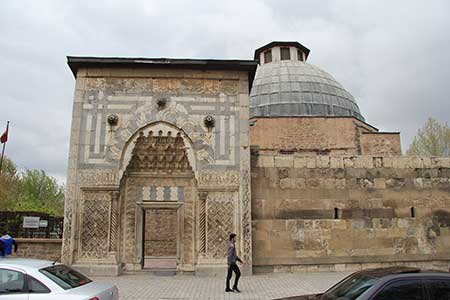 |
The theatre of Asependos |
The Karatay Medrese in Konya |
The next day we left Antalya heading for Perge but a huge storm came through and made our visit impossible � the rain was torrential and flooded much of Antalya. We continued on our way, stopping instead to see an Ottoman bridge over the Eurymedon River, and then at the ancient site of Aspendos. This is an ancient Roman city which includes a magnificent theatre, stadium, walls, agora and aqueduct. The theatre of Aspendos, dating from the time of Marcus Aurelius (AD 161-80), is one of the best preserved theatres from antiquity. We continued our journey, heading up into the Taurus Mountains through winding passes and many snow covered hills. Our journey would take us to Konya which would be our next base for a few days.
Konya lies on an upland plateau ringed with snow covered hills. We stayed for 2 nights. On the first morning we drove SE of Konya to visit the ruins of the Neolithic city of Catal Huyuk. It was bitterly cold when we got there and we were very happy to shelter inside the enormous protective roof covers which shield the site from the elements. Catal Huyuk was occupied from 7500-5700 BC and preserves a rich array of artefacts (some on display in the on site Museum) and wall paintings. We explored the remains of the houses and enjoyed seeing the reconstructed house, which gives a good impression of what life was like in Neolithic times.
In the afternoon we returned to explore the old quarter of Konya. This city was a capital of the Selcuk Sultanate of Rum and has a rich array of wonderful 12th and 13th Century monuments. We explored the Karatay Medrese which has been turned into a Museum of Selcuk pottery and tiles � the roof of the main hall is wonderfully decorated with blue tiles. The Ince Minare Medrese contains an impressive collection of Selcuk wood and stone carving. We also went to see the Mevlana Museum of Rumi, founder of the Whirling Dervish movement, the Archaeology Museum of Konya which includes objects from Catal Huyuk and other sites nearby, and the Seljuk era Alaettin Mosque with its royal tombs from the 13th Century.
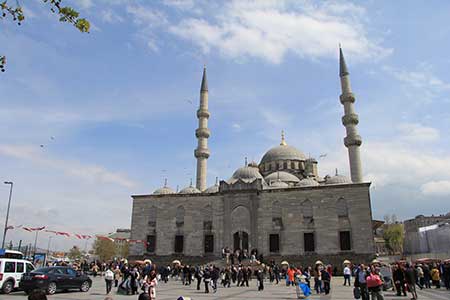 |
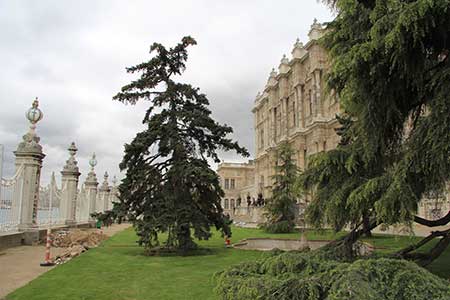 |
The 'New Mosque' in Istanbul |
Dolmabahce Palace |
On the 16th April we headed north of Konya towards the ruins of Gordion, stopping en route to see an Ottoman caravanserai which was being used by a group of school children for a fundraising event � we got a very warm welcome and bought some sweets. Heading north we saw many storks along the road and stopped a number of times to get some photos. We then headed to the ancient ruins of Gordion � we visited the enormous burial tumulus of King Midas � a passageway leads to a wood lined chamber whether an ancient king was found with his grave goods. Across the road, an excellent little museum contained a wealth of artefacts from the town and other tumuli. We then drove down to the excavation site to see the ruins of the Phyrgian city � it was bitterly cold but we explored the impressive gateway and royal structures. From here we headed east the short distance to Ankara.
Ankara was cold and grew while we were there. We visited the very good Ethnographic Museum which I had not seen previously � it contains some very beautiful ceramics, metalware and woodwork from Turkish history. In the afternoon we went to the Archaeological Museum. This is currently under restoration and only the key highlights of the collection were on display in the central hall. But these are of great interest and in a way it is good to just see the most significant pieces and not be overwhelmed by the collection. For me the most impressive pieces are the stunning relief slabs from Carcemish discovered by Leonard Woolley and Lawrence of Arabia in the pre-WWI period. We had a chance to walk around the citadel area and browse through some of the shops, particularly the gemstones and crystals, of which they have a good collection for sale.
The following day we flew back to Istanbul after what had been a remarkable journey through the east of Turkey. We felt that we had been somewhere exotic and different, made all the better for being somewhat out of season and blissfully free of other travelers.
We had a few days in Istanbul to explore some more of the sights. On the 18th April we went for a walk down to the Eminonu area to see the Egyptian Spice Bazaar � this was busy with tourists browsing the counters. The shops are increasingly catering to sweets and trinkets which is a shame since the market has lost its original feel and smell. We had a look at the so-called 'New Mosque' which was built in the 16th Century. I was surprised to see so many veiled women in the area, and also the dolling out of free food � the Islamist Government in Turkey is clearly attempting to bribe the locals with such actions and I found it offensive and cynical. The following day we went along the Bosphorus to visit the magnificent Dolmabahce Palace. Constructed by Sultan Abdul-Mecit in the mid-19th Century, it was lavishly decorated in a European style. Our visit included the state rooms and harem. We walked back to Galata and stopped to have a look at a fascinating exhibition on the Ottoman explorer and cartographer Piri Reis in the old armoury � they mainly had reproduction of his famous maps but they were fascinating never-the-less because they give a bird�s eye view of the cities and landscapes around the Mediterranean.
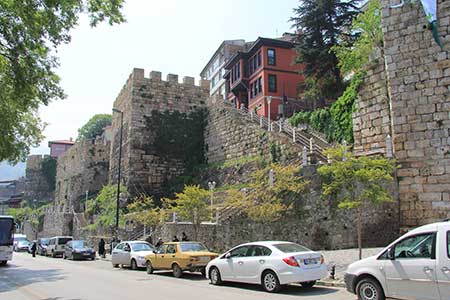 |
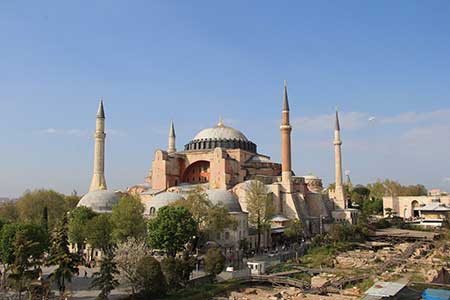 |
The walls of Bursa |
Haghia Sophia � the great basilica of Justinian |
On the 20th April we went to see the wonderful display of tulips in Gulhane Park, the main gardens near Topkapi Palace. The weather was still a bit cool, but the flowers were stunning, arranged in different patterns along the walkways. We stopped to have a look at the Museum of Islamic Science and Technology � it is fascinating and contains a huge range of reproductions of Islamic astrolabes, lifting devices and astronomical tools. We then had a coffee in one of the cafes overlooking the Bosphorus � it was raining so we were glad of a hot drink and shelter. We walked back through the gardens and went to the Archaeological Museum. The collection of artefacts is huge and it is possible to concentrate on only a small fraction � the collection from Troy is always fascinating.
The following day we went to Topkapi Museum � it is always wonderful to wander through the tiled rooms of the harem. New sections were open, having been restored, which is always a bonus. The display of tulips in the gardens was stunning with bright orange ones as far as you could see. In the afternoon we had some lunch in a caf� overlooking Haghia Sophia and the recent excavations of the Byznatine Palace and then went for a walk through the Sultanahmet district. This included a visit to the Basilica of St Sergius and St Bacchus, which was built by the Emperor Justinian in the 6th Century � it contains a wonderful courtyard which has now been converted into an artist�s workshop.
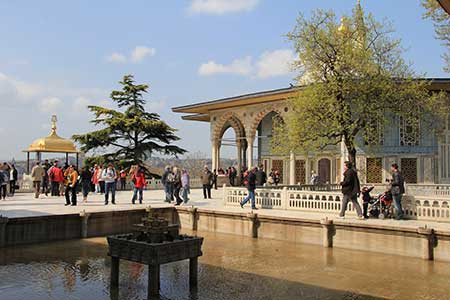 |
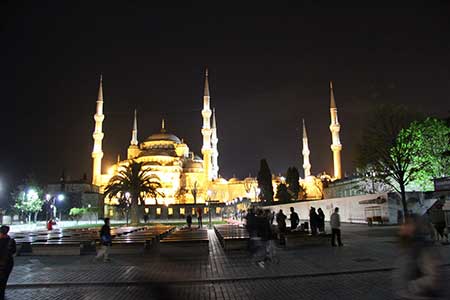 |
Topkapi Palace |
The Blue Mosque in Istanbul |
The following morning, the 22nd April, we had arranged to take the fast ferry from Istanbul down to Bursa. It was a beautiful clear day and we had a good view of the Princes' islands which lie off Seraglio Point in the Sea of Marmara. We had 3 nights in Bursa to explore the historic early Ottoman quarter with its wonderful tomb complexes from the 14th Century. We enjoyed seeing the Selcuk and Ottoman pottery in the local Museum, went to the Archaeological Museum, and also saw the Museum of Puppetry with an emphasis on the Ottoman characters Karagoz and Hacivat. We also took a day trip to the east of Bursa to see the antiquities of Iznik; we had a look at the early Basilica, used in one of the early Ecumenical Councils, walked around the Late Roman walls of the city and visited the Ottoman mosques. The town had the sleepy feel of another time and place. It is famous for its ceramics and we had a look at a few workshops which produce good quality reproductions of Ottoman vases. We returned to Istanbul for one last night � a highlight was dinner on the roof of the Panorama Restaurant with a stunning view of the moon rising between the minarets of the Haghia Sophia.
Michael Birrell
